TeamPass è un gestore di password collaborativo utilizzato per gestire le password e condividerle tra i membri del team. Utilizza il database MySQL/MariaDB per memorizzare le password in modo sicuro. Fornisce un potente strumento per personalizzare l'accesso delle password in base ai ruoli degli utenti. È un software gratuito e open-source e consente di gestire le proprie password e i relativi dati in modo organizzato rispetto ai diritti di accesso definiti per ciascun utente. Viene fornito con un ricco set di funzionalità tra cui crittografia dei dati, cartella personale, struttura ad albero, privilegi utente, definizione dei ruoli e molto altro.
In questo tutorial, ti mostreremo come installare il software TeamPass Password Manager su Ubuntu 20.04 con Let's Encrypt SSL.
Prerequisiti
- Un server che esegue Ubuntu 20.04.
- Un nome di dominio valido è puntato all'IP del tuo server.
- Sul server è configurata una password di root.
Installa il server LAMP
Prima di iniziare, assicurati che il server LAMP sia installato nel tuo server. Se non è installato, puoi installarlo con un altro pacchetto eseguendo il comando seguente:
apt-get install apache2 mariadb-server php7.4 php7.4-cli libapache2-mod-php7.4 php7.4-mysql php7.4-curl php7.4-mbstring php7.4-bcmath php7.4-common php7.4-gd php7.4-xml git wget -y
Una volta installato il server LAMP, modifica il file php.ini e cambia alcune impostazioni:
nano /etc/php/7.4/apache2/php.ini
Modifica le seguenti righe:
memory_limit = 256M upload_max_filesize = 100M max_execution_time = 360 date.timezone = Asia/Kolkata
Una volta terminato, puoi procedere al passaggio successivo.
Crea database TeamPass
Successivamente, dovrai creare un database e un utente per TeamPass. Innanzitutto, accedi alla shell di MariaDB con il seguente comando:
mysql -u root
Una volta effettuato l'accesso, crea un database e un utente per TeamPass con il seguente comando:
MariaDB [(none)]> create database teampass;
MariaDB [(none)]> grant all privileges on teampass.* to [email protected] identified by "password";
Quindi, svuota i privilegi ed esci da MariaDB con il seguente comando:
MariaDB [(none)]> flush privileges;
MariaDB [(none)]> exit;
Una volta creato il database, puoi procedere al passaggio successivo.
Scarica TeamPass
Innanzitutto, dovrai scaricare l'ultima versione di TeamPass dal repository Git. Puoi scaricarlo nella directory principale web di Apache con il seguente comando:
cd /var/www/html
git clone https://github.com/nilsteampassnet/TeamPass.git
Una volta completato il download, cambia la proprietà all'utente www-data e imposta l'autorizzazione appropriata con il seguente comando:
chown -R www-data.www-data /var/www/html/TeamPass/
chmod -R 775 /var/www/html/TeamPass/
Una volta terminato, puoi procedere al passaggio successivo.
Configura server Web Apache
Innanzitutto, crea un file di configurazione dell'host virtuale Apache per TeamPass con il seguente comando:
nano /etc/apache2/sites-available/teampass.conf
Aggiungi le seguenti righe:
<VirtualHost *:80>
ServerAdmin [email protected]
DocumentRoot /var/www/html/TeamPass
ServerName teampass.linuxbuz.com
<Directory /var/www/html/TeamPass>
Options FollowSymlinks
AllowOverride All
Require all granted
</Directory>
ErrorLog ${APACHE_LOG_DIR}/teampass_error.log
CustomLog ${APACHE_LOG_DIR}/teampass_access.log combined
</VirtualHost>
Salva il file quando hai finito. Quindi, abilita il file dell'host virtuale Apache e riavvia il servizio Apache per applicare le modifiche:
a2ensite teampass
systemctl restart apache2
Una volta configurato il tuo server web Apache, puoi procedere al passaggio successivo.
TeamPass sicuro con Let's Encrypt SSL
.In primo luogo, dovrai installare il client Certbot Let's Encrypt nel tuo server. Viene utilizzato per installare e gestire il certificato SSL Let's Encrypt per il tuo dominio. Esegui il comando seguente per installare Certbot
apt-get install python3-certbot-apache -y
Una volta installato Certbot, esegui il seguente comando per scaricare e installare Let's Encrypt SSL per il tuo sito web:
certbot --apache -d teampass.linuxbuz.com
Dovrai fornire il tuo indirizzo email valido e accettare i termini del servizio come mostrato di seguito:
Saving debug log to /var/log/letsencrypt/letsencrypt.log Plugins selected: Authenticator apache, Installer apache Enter email address (used for urgent renewal and security notices) (Enter 'c' to cancel): [email protected] - - - - - - - - - - - - - - - - - - - - - - - - - - - - - - - - - - - - - - - - Please read the Terms of Service at https://letsencrypt.org/documents/LE-SA-v1.2-November-15-2017.pdf. You must agree in order to register with the ACME server at https://acme-v02.api.letsencrypt.org/directory - - - - - - - - - - - - - - - - - - - - - - - - - - - - - - - - - - - - - - - - (A)gree/(C)ancel: A - - - - - - - - - - - - - - - - - - - - - - - - - - - - - - - - - - - - - - - - Would you be willing to share your email address with the Electronic Frontier Foundation, a founding partner of the Let's Encrypt project and the non-profit organization that develops Certbot? We'd like to send you email about our work encrypting the web, EFF news, campaigns, and ways to support digital freedom. - - - - - - - - - - - - - - - - - - - - - - - - - - - - - - - - - - - - - - - - (Y)es/(N)o: Y Obtaining a new certificate Performing the following challenges: http-01 challenge for teampass.linuxbuz.com Enabled Apache rewrite module Waiting for verification... Cleaning up challenges Created an SSL vhost at /etc/apache2/sites-available/teampass-le-ssl.conf Enabled Apache socache_shmcb module Enabled Apache ssl module Deploying Certificate to VirtualHost /etc/apache2/sites-available/teampass-le-ssl.conf Enabling available site: /etc/apache2/sites-available/teampass-le-ssl.conf
Successivamente, dovrai selezionare se reindirizzare o meno il traffico HTTP su HTTPS come mostrato di seguito:
Please choose whether or not to redirect HTTP traffic to HTTPS, removing HTTP access. - - - - - - - - - - - - - - - - - - - - - - - - - - - - - - - - - - - - - - - - 1: No redirect - Make no further changes to the webserver configuration. 2: Redirect - Make all requests redirect to secure HTTPS access. Choose this for new sites, or if you're confident your site works on HTTPS. You can undo this change by editing your web server's configuration. - - - - - - - - - - - - - - - - - - - - - - - - - - - - - - - - - - - - - - - - Select the appropriate number [1-2] then [enter] (press 'c' to cancel): 2
Digita 2 per fare in modo che tutte le richieste vengano reindirizzate per proteggere l'accesso HTTPS e premi Invio per installare Let's Encrypt SSL. Una volta che l'installazione è stata completata con successo, dovresti vedere il seguente output:
Enabled Apache rewrite module Redirecting vhost in /etc/apache2/sites-enabled/teampass.conf to ssl vhost in /etc/apache2/sites-available/teampass-le-ssl.conf - - - - - - - - - - - - - - - - - - - - - - - - - - - - - - - - - - - - - - - - Congratulations! You have successfully enabled https://teampass.linuxbuz.com You should test your configuration at: https://www.ssllabs.com/ssltest/analyze.html?d=teampass.linuxbuz.com - - - - - - - - - - - - - - - - - - - - - - - - - - - - - - - - - - - - - - - - IMPORTANT NOTES: - Congratulations! Your certificate and chain have been saved at: /etc/letsencrypt/live/teampass.linuxbuz.com/fullchain.pem Your key file has been saved at: /etc/letsencrypt/live/teampass.linuxbuz.com/privkey.pem Your cert will expire on 2020-10-17. To obtain a new or tweaked version of this certificate in the future, simply run certbot again with the "certonly" option. To non-interactively renew *all* of your certificates, run "certbot renew" - Your account credentials have been saved in your Certbot configuration directory at /etc/letsencrypt. You should make a secure backup of this folder now. This configuration directory will also contain certificates and private keys obtained by Certbot so making regular backups of this folder is ideal. - If you like Certbot, please consider supporting our work by: Donating to ISRG / Let's Encrypt: https://letsencrypt.org/donate Donating to EFF: https://eff.org/donate-le
A questo punto, il tuo sito web è protetto con Let's Encrypt SSL. Ora puoi accedervi in modo sicuro con il protocollo HTTPS.
Accedi all'interfaccia utente Web di TeamPass
Ora accedi alla tua interfaccia web di TeamPass visitando l'URL https://teampass.linuxbuz.com. Dovresti vedere la schermata di benvenuto di TeamPass:

Fai clic su AVANTI pulsante. Dovresti vedere la schermata dei controlli del server:
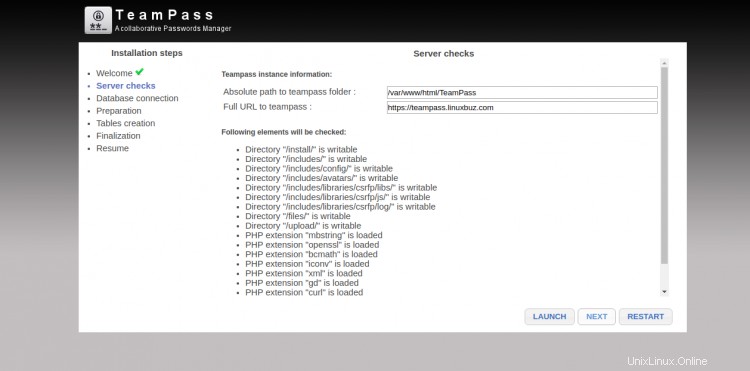
Fai clic su AVVIO e AVANTI pulsante. Dovresti vedere la schermata di connessione al database:
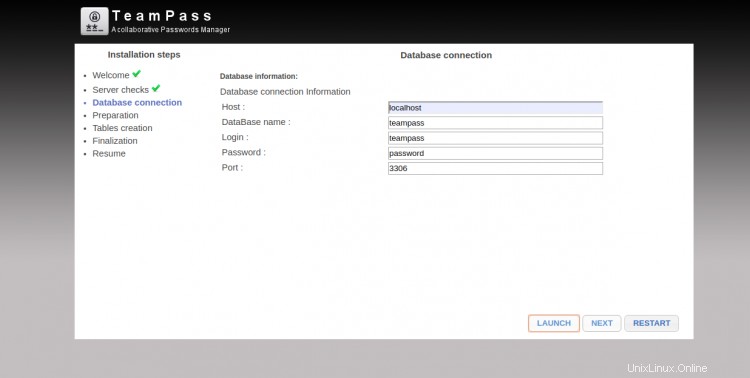
Fornisci i dettagli del tuo database e fai clic su AVVIA e AVANTI pulsante. Dovresti vedere la schermata di preparazione:
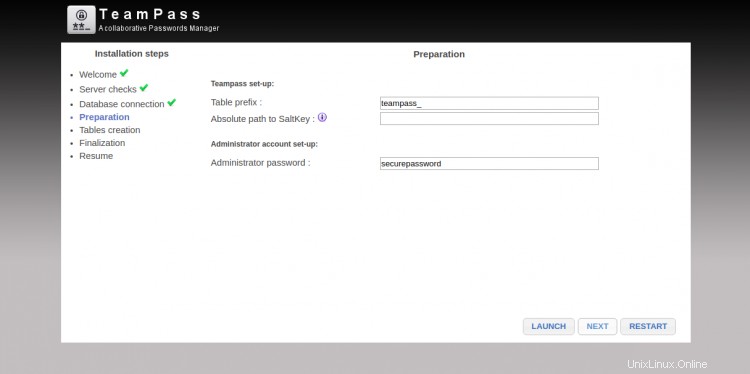
Fai clic su AVVIO e AVANTI pulsante. Dovresti vedere la schermata di creazione della tabella:
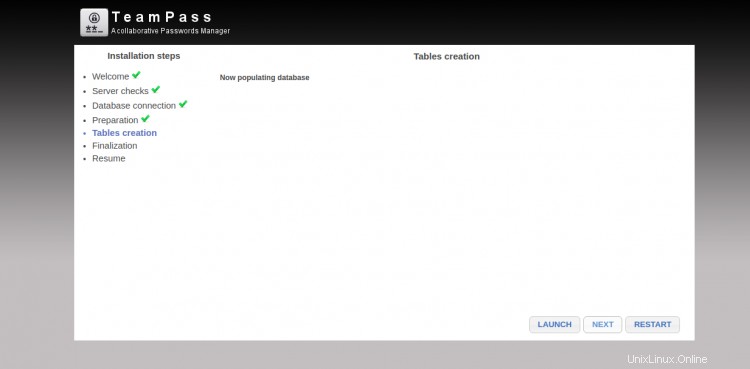
Fai clic su AVVIO e AVANTI pulsante. Dovresti vedere la schermata di finalizzazione:
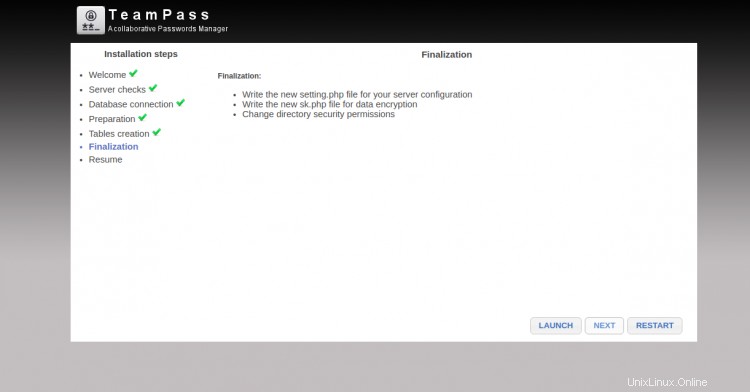
Fai clic su AVVIO e AVANTI pulsante. Una volta che l'installazione è stata completata con successo, dovresti vedere la seguente schermata:
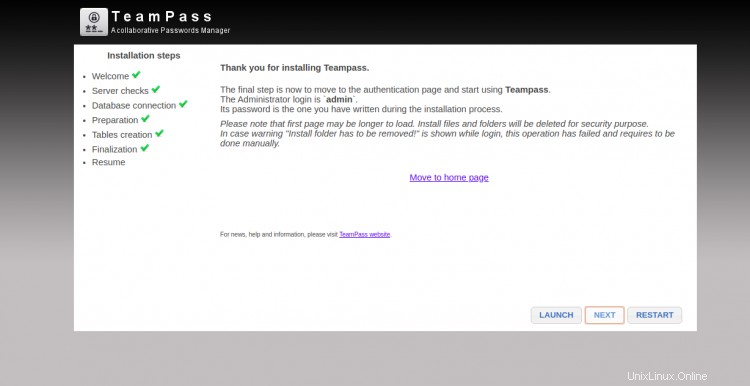
Ora, fai clic su Sposta alla home page pulsante. Verrai reindirizzato alla schermata di accesso di TeamPass come mostrato di seguito:
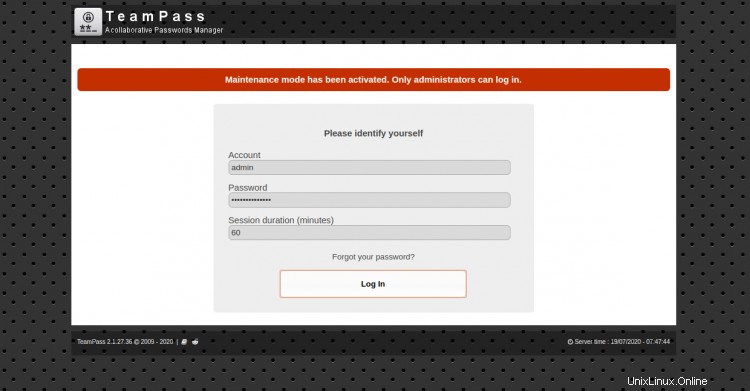
Fornisci il tuo nome utente come amministratore e la password che hai scritto durante il processo di installazione e fai clic sul Registro In pulsante. Dovresti vedere la dashboard di TeamPass nella schermata seguente:
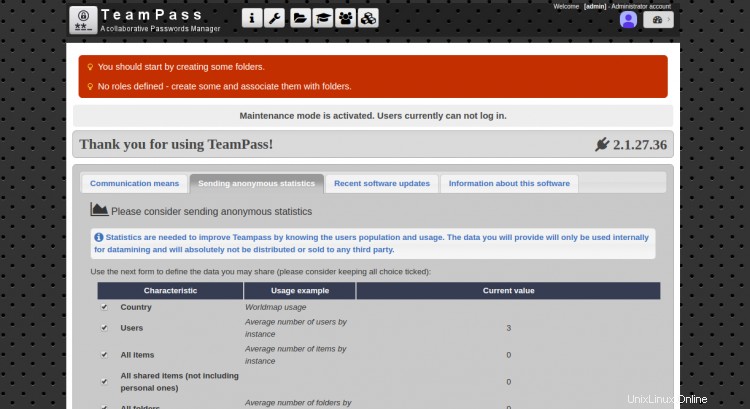
Conclusione
In questa guida hai imparato come installare il gestore password TeamPass su Ubuntu 20.04 e proteggerlo con Let's Encrypt SSL. Ora puoi esplorare TeamPass e distribuirlo nell'ambiente di produzione. Per ulteriori informazioni, visita la documentazione ufficiale di TeamPass.